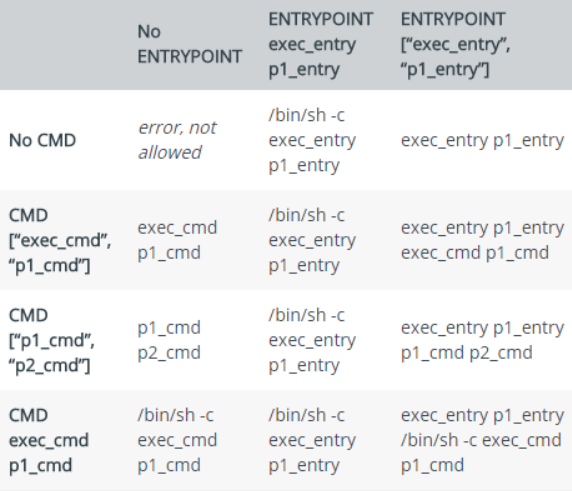The Tips About Dockerfile
January 18, 2025 · 3 min read · Page View:
If you have any questions, feel free to comment below. And if you think it's helpful to you, just click on the ads which can support this site. Thanks!
Normally, we often write a Dockerfile in the current directory.
- The
Dockerfileis a configuration file that describes how to build the image. You can refer to the official documentation for more details. - If you list more than one
CMD, only the last one takes effect. So if you have multiple commands to run, you better write them in a script file. - Docker is not the VMware, there is no
systemdin the container. Its startup program is the container application process. The container exists for the main process. Once the main process exits, the container loses its meaning of existence and thus exits. So when you execute multiple commands and if they are blocking, you better write the previous commands in nohup and the last command in the blocking command. (never use the command such asCMD service nginx start, the CMD only will execute asCMD [ "sh", "-c", "service nginx start"], when the sh is executed, the container will exit, the correct way is run it directlyCMD ["nginx", "-g", "daemon off;"])
Then, run the following command to build the image:
docker build -t my_image:1.0 .: the -t means tag, the . means the current directory(actually, it is the context of the dockerfile, but considering many people only use the same method, so here call it current). Besides, you can also build from .tar.gz file.
You can just refer to the official docs, but there is only one command that you should pay attention to: ENTRYPOINT.
If you want to tell the difference between CMD and ENTRYPOINT, you should first understand the shell pattern and the exec pattern.
exec pattern #
The feature of exec pattern is that it will not pass the command through the shell. So the environment variables such as $HOME will not be passed.
CMD [ "echo", "$HOME" ]
... run docker run ...
... output: $HOME
But use the exec to run the shell you can get the correct result.
CMD [ "sh", "-c", "echo", "$HOME" ]
... run docker run ...
... output: /root
shell pattern #
The shell pattern will execute the command via /bin/sh -c "task command", which means the no.1 process is not the task process but the bash process.
CMD top
... run docker run ...
PID1 /bin/sh -c top
PID7 top
CMD #
There are three ways to use CMD.
CMD ["executable","param1","param2"](exec pattern)CMD ["param1","param2"](provide the entrypoint parameters)
CMD command param1 param2(shell pattern) ==CMD ["sh", "-c", "command param1 param2"]
The both pattern of CMD command will be overwritten by the command in the end of the docker run command.
The overwrite command will also run in the same pattern.
# Example 1
CMD echo "hello"
# docker run my_image:1.0 top
# top
# Example 2
ENTRYPOINT ["/bin/echo", "Hello,"]
CMD ["world!"]
# docker run myimage "GPT3"
# Hello, GPT3
ENTRYPOINT #
There are two ways to use ENTRYPOINT.
ENTRYPOINT ["executable","param1","param2"](exec pattern)ENTRYPOINT command param1 param2(shell pattern)
In exec pattern, the ENTRYPOINT command will not be overwritten by the command in the end of the docker run command. Such as docker run my_image:1.0 -c. The -c will not overwrite the ENTRYPOINT [ "top", "-b" ], but it will be added to the ENTRYPOINT command as ENTRYPOINT [ "top", "-b", "-c" ].
In shell pattern, your custom command will be ignored by the ENTRYPOINT command. Such as docker run my_image:1.0 -c. The -c will be ignored by the ENTRYPOINT top, and the command will still be top.
You can also overwrite the
ENTRYPOINTcommand by using the--entrypoint xxxfollow thedocker runcommand.
You can choose CMD or ENTRYPOINT according to your specific needs.
- If you want to create an image with default behavior, and allow users to override the default behavior, you can use
CMD. - If you want to create an image that always executes a specific command, and allows users to pass parameters, you can use
ENTRYPOINT. - At the same time,
CMDandENTRYPOINTcan also be used together, in which case the parameters specified inCMDwill be used as the default parameters for the command specified byENTRYPOINT.
conclusion #
- shellmode: The main process(pid 1) is the
/bin/shprocess, which can resolve the environment variables. - execmode: The main process is the command you specify, and the environment variables will not be resolved.
- If ENTRYPOINT uses shellmode, the default CMD instruction will be ignored.
- If ENTRYPOINT uses execmode, the content specified in default CMD instruction will be appended as parameters for the command specified by ENTRYPOINT. If ENTRYPOINT uses execmode, the default CMD instruction should also use exec mode.

Related readings
If you find this blog useful and want to support my blog, need my skill for something, or have a coffee chat with me, feel free to: